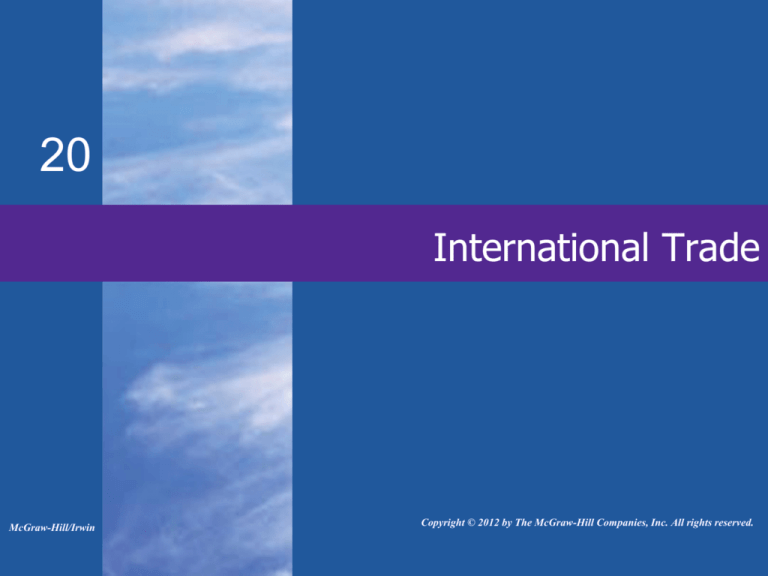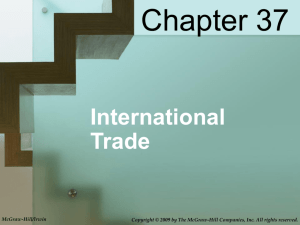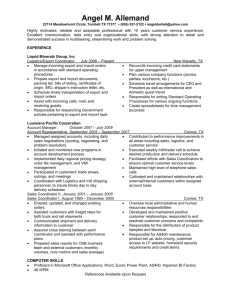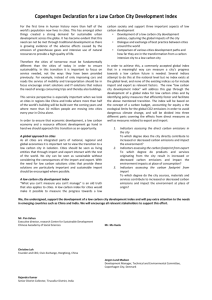
20
International Trade
McGraw-Hill/Irwin
Copyright © 2012 by The McGraw-Hill Companies, Inc. All rights reserved.
Some Key Trade Facts
• U.S. trade deficit in goods
• $517 billion in 2009
• U.S. trade surplus in services
• $138 billion in 2009
• Canada largest U.S. trade partner
• Trade deficit with China
• $220 billion in 2009
• Exports are 13% U.S. output
• Dependence on oil
LO1
20-2
Some Key Trade Facts
• Principal U.S. exports include:
• Chemicals
• Agricultural products
• Consumer durables
• Semiconductors
• Aircraft
• U.S. provides about 8.5% of world’s
exports
LO1
20-3
Some Key Trade Facts
• Principal U.S. imports include:
• Petroleum
• Automobiles
• Metals
• Household appliances
• Computers
LO1
20-4
Some Key Trade Facts
LO1
20-5
Some Key Trade Facts
LO1
20-6
Economic Basis for Trade
• Nations have different resource
•
•
•
LO2
endowments
Labor-intensive goods
Land-intensive goods
Capital-intensive goods
20-7
Comparative Advantage
• Assumptions
• Two nations
• Same size labor force
• Constant costs in each country
• Different costs between countries
• U.S. absolute advantage in both
• Opportunity cost ratio
• Slope of the curve
• Vegetables sacrificed per ton of beef
LO2
20-8
Comparative Advantage
(a) United States
45
40
40
35
35
30
30
Vegetables (Tons)
Vegetables (Tons)
45
25
20
15
12
10
A
20
15
5
4
5
10
15 18 20
Beef (Tons)
LO2
25
10
5
0
(b) Mexico
25
30
0
Z
5
8 10
15
20
Beef (Tons)
20-9
Comparative Advantage
• Self-sufficiency output mix
• Specialization and trade
• Produce the good with the lowest
domestic opportunity cost
• Opportunity cost of 1 ton of beef:
• 1 pound of vegetables in U.S.
• 2 pounds of vegetables in Mexico
LO2
20-10
Comparative Advantage
LO2
20-11
Comparative Advantage
• Terms of trade
• U.S. 1V = 1B
• U.S. will sell 1B for more than 1V
• Mexico 2V = 1B
• Mexico will pay less than 2V for 1B
• Settle between the two
• Depends on supply/demand factors
• Assume 1B = 1.5V
LO2
20-12
Comparative Advantage
• Gains from trade
• Trading possibilities line
• Slope equals terms of trade
• Improved options
• Complete specialization
• More of both goods
• More efficient resource allocation
LO2
20-13
Gains from Trade
(a) United States
45
(b) Mexico
45
V’
40
40
35
30
30
V
Vegetables (Tons)
Vegetables (Tons)
35
Trading
Possibilities Line
25
20
A’
15
12
25
20
Trading
Possibilities Line
v
15
A
10
10
Z’
5
0
5
4
B
5
10
15 18 20
Beef (Tons)
LO2
25
30
Z
W
0
5
b
8 10
b’
15
20
Beef (Tons)
20-14
Comparative Advantage
• Trade with increasing costs
• Concave production curve
• Resources not perfectly
•
LO2
substitutable
• Incomplete specialization
Case for free trade
• Promote efficiency
• Promote competition
20-15
Supply and Demand Analysis
• World price
• Domestic price with no trade
• World price > domestic price
• Export surplus
• Export supply curve
• World price < domestic price
• Import shortage
• Import supply curve
LO3
20-16
Supply and Demand Analysis
Surplus = 100
(b) U.S. Export Supply
and Import Demand
Sd
1.50
1.50
Surplus = 50
1.25
c
1.25
1.00
1.00
.75
Shortage = 50
.50
0
50
75
100
125
Quantity of Aluminum
(Millions of Pounds)
b
U.S.
Export
Supply
a
U.S.
Import
Demand
.75
x
.50
y
Dd
Shortage = 100
LO3
Price (Per Pound; U.S. Dollars
Price (Per Pound; U.S. Dollars
(a) U.S. Domestic
Aluminum Market
150
0
50
100
Quantity of Aluminum
(Millions of Pounds)
20-17
Supply and Demand Analysis
(b) Canada’s Export Supply
and Import Demand
1.50
1.50
Surplus = 100
Sd
1.25
1.25
Surplus = 50
s
1.00
1.00
.75
.50
Shortage = 50
Dd
0
50
75
100
125
Quantity of Aluminum
(Millions of Pounds)
LO3
Price (Per Pound; U.S. Dollars
Price (Per Pound; U.S. Dollars
(a) Canada’s Domestic
Aluminum Market
150
.75
r
Canadian
Export
Supply
q
Canadian
Import
Demand
.50
t
0
50
100
Quantity of Aluminum
(Millions of Pounds)
20-18
International Equilibrium
Price (Per Pound; U.S. Dollars
• Import demand = Export supply
LO3
U.S.
Export
Supply
Canadian
Export
Supply
1.00
.88
.75
e
Equilibrium
U.S.
Import
Demand
Canadian
Import Demand
0
50
100
Quantity of Aluminum
(Millions of Pounds)
20-19
Trade Barriers and Export Subsidies
• Tariffs
• Revenue tariff
• Protective tariff
• Import quota
• Nontariff barrier (NTB)
• Voluntary export restriction
•
LO4
(VER)
Export subsidy
20-20
Economic Impact of Tariffs
• Direct effects
• Decline in consumption
• Increase in domestic production
• Decline in imports
• Tariff revenue
• Indirect effects
LO4
20-21
Economic Impact of Quotas
• Decline in consumption
• Increase in domestic production
• Decline in imports
• Quotas do not provide for any
government revenue but instead
transfer it to foreign producers
LO4
20-22
Economic Effects of Tariff/Quota
Sd
Price
Sd + Q
Pd
Pt
Pw
Dd
0
LO4
a
b
q c d
Quantity
20-23
The Case for Protection
• Military self-sufficiency
• Diversification for stability
• Infant industry
• Protection against dumping
• Increased domestic employment
• Cheap foreign labor
LO5
20-24
Multilateral Trade Agreements
• General Agreement on Tariffs and
•
•
•
LO5
Trade (GATT)
World Trade Organization (WTO)
European Union (EU)
North American Free Trade
Agreement (NAFTA)
20-25
GATT
• Three principles:
• Equal, nondiscriminatory trade
between member nations
• Reduction in tariffs
• Elimination of import quotas
LO5
20-26
WTO
• Established by Uruguay Round of
•
•
•
LO5
GATT
153 member nations in 2010
Oversees trade agreements and rules
on disputes
Critics argue that it may allow nations
to circumvent environmental and
worker-protection laws
20-27
European Union
• Initiated in 1958 as Common Market
• Abolished tariffs and import quotas
•
•
LO5
between member nations
Established common tariff with
nations outside the EU
Created Euro Zone with one currency
20-28
NAFTA
• Agreement between U.S., Canada,
•
•
•
LO5
and Mexico
Established a free trade zone
between the countries
Trade has increased in all countries
Enhanced standard of living
20-29
Trade Adjustment and Offshoring
• Trade Adjustment Assistance Act
• Designed to help individuals hurt by
•
LO5
international trade
Offshoring of jobs
• Shifting of work previously done by
American workers to workers
abroad
20-30
Petition of the Candlemakers
• Petition of candlemakers asking for
•
LO5
protection from natural light producers
such as the sun
Tongue-in-cheek argument
supporting the idea of free trade
20-31








